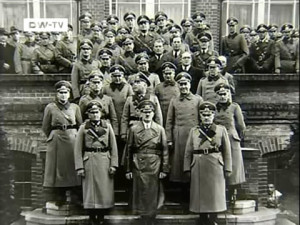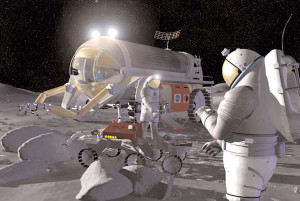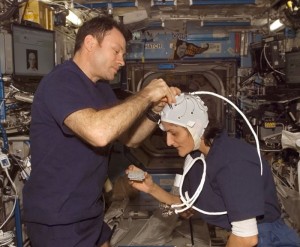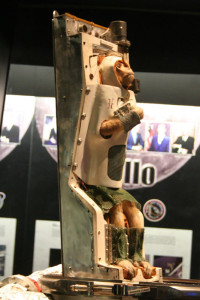In “Bowled Over,” we examined von Braun’s most terrifying invention, the Nazi V-2:
The V-2, or Vergeltungswaffe 2, was the first ballistic missile to reach sub-orbital spaceflight and was the forerunner of modern rockets. Over 3,000 V-2s were launched at Allied targets by the German Wehrmacht in World War II, killing an estimated 7,250 military personnel and civilians, mostly in London.
Over 20,000 Mittelbau-Dora concentration camp inmates died constructing V-2s, with 9000 dying from exhaustion alone. Around 350 of these Nazi slaves were hanged, including 200 for sabotage, with the remainder shot or dying from disease and starvation. Von Braun, an officer in the Waffen-SS from May 1940 until the end of the war when he escaped with 120 scientists to surrender to the Americans, admitted working at the V-2 plant many times but denied ever visiting the nearby concentration camp.
However, von Braun disclosed in an August 15, 1944 letter to the manager of V-2 production that he personally selected labor slaves from the Buchenwald concentration camp to work at the rocket factory, slaves he described 25 years later in an interview as being in “pitiful shape.”
Equally at home in photographs with Hitler and Himmler as well as presidents Eisenhower and Kennedy, von Braun’s work on the Apollo Space Program earned him the National Medal of Science from President Ford in 1977.
The Mittelbau-Dora concentration camp supplied slave labor for Nordhausen missile works, where prisoners were fed a single piece of bread a day and literally worked to death. Nazi aviation doctors suffocated gypsies in pressure chambers and force-fed Jews nothing but seawater for weeks in gruesome experiments to determine what pilots could endure.
Von Braun was not the only Nazi among the 765 German scientists imported to the United States between 1945 and 1955. Approximately 80% of these men were members of the National Socialist German Worker’s Party. Nor were scientists the only Nazi export harvested during America’s Operation Paperclip which continued until 1973,. America brought the darker legacy of Nazi Germany with it returning home.
Operation Paperclip built on the results of Nazi research on captive human subjects. Researchers hoping to develop a truth serum at the Edgewood Arsenal, in Maryland, worked with Operation Paperclip personnel to test psychoactive drugs on almost 7,000 unwitting American soldiers between 1955 and 1975.
“Those experiments, and Paperclip itself, were among the first manifestations of what became a guiding principle of the Cold War, that the ends sometimes justified the means” wrote Christine Gibson, a former editor at American Heritage magazine.
“I have always been outraged at the adoration our country has given this Nazi von Braun,” says the Reverend John Southwick of Simi Valley, California. “I grew up in the London Blitz in WWII. Those Nazis took away my childhood.”
“I lived three miles from the de Havilland Aircraft Company aircraft factory where they built engines for fighters,” says Southwick who grew up in Edgeware, a pleasant suburb ten miles outside of central London with a large Jewish population. “The plant was well camouflaged, but the Nazis tried to bomb it from 1939 to 1945. They never hit it but the houses all around it were hit. My house was hit twice, not a direct hit but lots of damage.”
Southwick now lives next to the former Rocketdyne lab where von Braun’s German test stands were recreated. “Getting us to the moon was a great feat, but nothing can wipe away the shame of being responsible for thousands of deaths. Von Braun never owned up to his role in World War II,” Southwick says.
“The Good Reverend John” Southwick is a member of a community activist group called the Radiation Rangers who have such monikers as “Toxic Terry” and “Perchlorate Patty.”
The group has fought development of land next to the lab in Runkle Canyon because of radiation and heavy metal contamination concerns. Since 2006, the Rangers have battled mega-developer KB Home over a proposed 461 home development in the canyon which has tested high in radioactive strontium-90 and heavy metals including arsenic, chromium and vanadium.
“Americans have always loved our space program and I’m no exception,” says Southwick. “But this collective amnesia about who von Braun really was speaks to a larger moral failing. The ‘anything goes’ mantra practiced by the aerospace industry and NASA itself, has polluted Rocketdyne with incredible amounts of contamination. The moral failing today is the lab owner, Boeing, and NASA doing everything they can to get out of that place before properly cleaning it up.”
Regardless, von Braun’s controversial past has not persuaded many aerospace workers that his contribution to American rocketry was nothing short of legendary. Robert S. Kraemer is one of them. Kraemer is the author of Rocketdyne: Powering Humans into Space (American Institute of Aeronautics and Astronautics, 2006), and served as head of Advanced Design at Rocketdyne and later as NASA’s Director of Planetary Exploration.
“It is noteworthy that von Braun’s progression of missions, from a reusable space shuttle to a space station to landing humans on Mars, is the plan that NASA adopted almost from its beginning, even though it would not appear as a formal written and approved plan for NASA until January 2004,” wrote Kraemer. “The vehicles have been scaled down a bit from von Braun’s conceptual designs, and a schedule for the Mars mission is still not set, but the plan is intact and as sound as ever.”
Soundly expensive. The International Space Station (ISS) is the most high-priced object ever constructed with cost estimates ranging from $35 billion to $160 billion. The ISS has been routinely criticized for its exorbitant expense and failed experiments, especially after the cancellation of the ambitious Centrifuge Accommodations Module. The cherished goal of mastering fusion on ISS has never materialized and most of the experiments requiring weightlessness could be done far cheaper in so-called “vomit comets” which are aircraft that can briefly provide a nearly weightless environment.
Ironically, the space station is already testing the effects of cosmic radiation on ISS astronauts wearing special ionization detection helmets that would appear to obviate the need to nuke the monkeys.
The Italian experiment began last summer and is described on the NASA website:
“Anomalous Long Term Effects in Astronauts’ Central Nervous System (ALTEA) integrates several diagnostic technologies to measure the effect of the exposure of crewmembers to cosmic radiation. It will improve the understanding of the impacts that radiation has on the human central nervous system functions, and will study the flashes from cosmic radiation that astronauts have reported since the Apollo flights.”
Instead of shooting up monkeys with radionuclides approximating some contrived correlation between large intravenous doses versus months of external cosmic radiation exposure, the Italians are cutting straight to the chase.
“ALTEA will measure the particle flux in the U.S. Lab on the International Space Station (ISS), being able to discriminate the type of particles, to measure their trajectories and the delivered energies. This will provide in-depth information on the radiation experienced and its impact on the nervous systems and visual perception. ALTEA will also develop new risk parameters and possible countermeasures aimed at the functional central nervous system risks.”
The Italian Space Agency’s experiment, launched on a Russian Soyuz rocket to ISS, will use an electroencephalograph (EEG) to measure the brain activity of crewmembers to determine if gamma radiation causes changes in the electrophysiology of the brain in real time.
“The neurophysiologic effects of cosmic radiation in long term space travel have never been explored with the depth of the ALTEA experiment,” reads the ALTEA page on NASA. “Data collected will help quantify risks to astronauts on future long distance space missions and propose optimized countermeasures.””
Presumably, the folks at NASA are aware of this experiment, which is looking for the very same answers that the squirrel monkey study ostensibly is. But there are two major differences between the Italian and American experiments: the Italians are studying the actual animals that tests are meant for – humans, not monkeys.
It also won’t cost $1.75 million taxpayer dollars, and the lives of up to 28 squirrel monkeys zapped by gamma radiation, to read the results. NASA may have to buy an English-Italian dictionary but that pretty much covers it.
It certainly won’t be as easy as translating another country’s experiment to figure out how hot it gets in space. President Obama will have to overcome Congressional pressure to continue a costly and scientifically dubious manned space program. That will be no easy mission to accomplish.
The American people, however, may prove pivotal in pressuring their legislators to support a robust robotic space exploration that would benefit tremendously from the dollars freed up by deep-sixing Constellation. Some, like Southwick, would certainly be satisfied if NASA finally jettisoned the remnants of its Nazi past.
Inhumane primate experiments and the exorbitant and expensive dreams of human space conquest may disappear into a stellar black hole like that created by the gravitational collapse of a massive dying star. Like the resultant supernova explosion that accompanies such a collapse, NASA’s robotic space program could then burst out with renewed brilliance.
It would be one small step for monkeys, one giant leap for robots.












Recent Comments